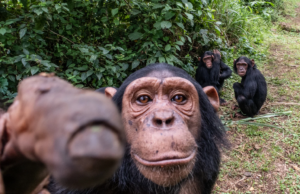Africa: Protecting Great Apes from diseases

By Ana Nuno, Chloe Chesney, Maia Wellbelove, Elena Bersacola, Gladys Kalema-Zikusoka, Fabian Leendertz, Amander Webber, and Kimberley Hockings
Nonhuman great apes (bonobos, chimpanzees, eastern gorillas, western gorillas and orangutans) are particularly vulnerable to infectious diseases from humans because of our close genetic relatedness. This vulnerability is highest in close-contact activities such as tourism and research. Though these activities can assist conservation efforts, the health risks are well documented. With the COVID-19 pandemic reviving concerns for disease transmission, the “Protect Great Apes from Disease” initiative was born (see http://www.protectgreatapesfromdisease.com. The website offers a lot of information and education material free for download in different languages). Check one of the videos available.
At an early stage of the pandemic, our team aimed to develop visitor education and guide-training materials for use in African sites of great ape tourism. To do so, we first explored what factors seem to best explain visitors’ compliance with disease mitigation measures. For example, we wanted to characterise practices during past visits (e.g. if people think visitors are generally compliant with recommendations), assess visitors’ willingness to comply with disease mitigation measures (e.g. would they wear a facemask during trekking to protect great apes?) and explore what factors should be promoted to increase their willingness to follow recommendations (e.g. were those more compliant more likely to be aware of potential impacts?). To answer these questions, 989 past and potential future visitors took our online questionnaire adapting the Health Belief Model, one of the most commonly used public health frameworks for understanding why individuals may or may not act in the face of a threat to health.
Through this greater understanding of the visitors to wild African great ape tourism sites we were able to identify ways of improving measures to reduce disease transmission. This is important not only for COVID-19 but other infectious diseases too, particularly at the early stages of future pandemics when information is generally limited but preventive action is required. In the face of growing threats from future pandemics, we must minimise disease transmission while ensuring that tourism and research promote long-term support for the conservation of great apes and their habitats as well as maximising benefits for local communities.
Full survey with free download: https://besjournals.onlinelibrary.wiley.com/doi/10.1002/pan3.10396

 Español
Español
 Português
Português








